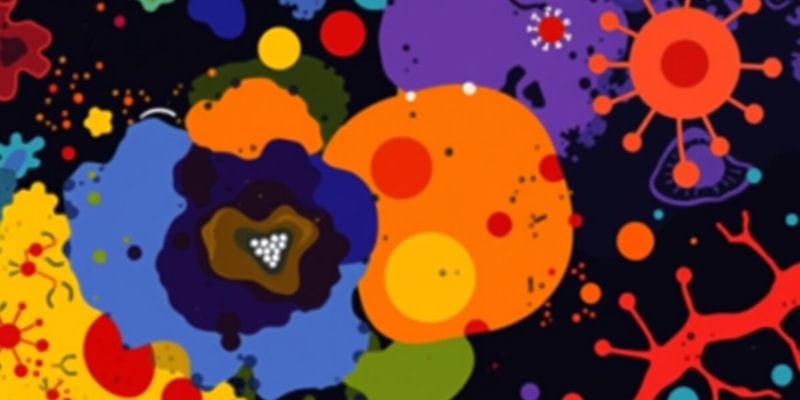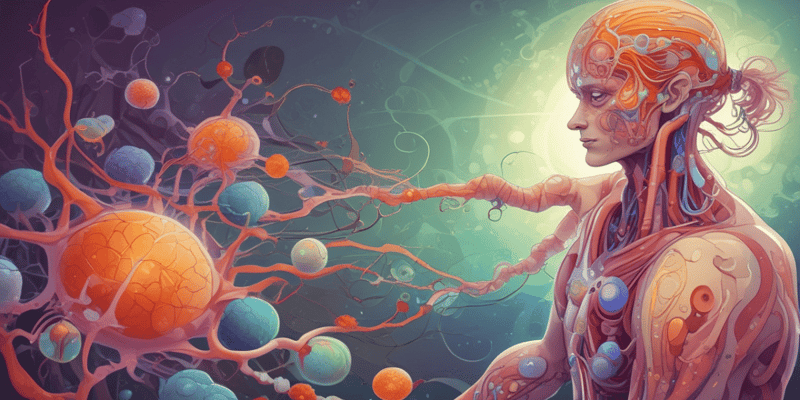Podcast
Questions and Answers
What is the primary purpose of the immune system?
What is the primary purpose of the immune system?
Which of the following is NOT a function of the immune system?
Which of the following is NOT a function of the immune system?
Which two main divisions comprise the immune system?
Which two main divisions comprise the immune system?
Which year in the curriculum focuses on advanced topics in immunopathologies?
Which year in the curriculum focuses on advanced topics in immunopathologies?
Signup and view all the answers
What does innate immunity primarily deal with?
What does innate immunity primarily deal with?
Signup and view all the answers
What is one recommended source for further information on immunology?
What is one recommended source for further information on immunology?
Signup and view all the answers
What concept will be revisited in Year 1 of the immunology curriculum?
What concept will be revisited in Year 1 of the immunology curriculum?
Signup and view all the answers
Which of the following processes is associated with innate immunity?
Which of the following processes is associated with innate immunity?
Signup and view all the answers
Which TLRs dimerize to recognize lipopolysaccharide (LPS)?
Which TLRs dimerize to recognize lipopolysaccharide (LPS)?
Signup and view all the answers
What is commonly associated with MyD88-dependent TLR4 signaling?
What is commonly associated with MyD88-dependent TLR4 signaling?
Signup and view all the answers
Which transcription factor is associated with MyD88-mediated signaling in TLR4?
Which transcription factor is associated with MyD88-mediated signaling in TLR4?
Signup and view all the answers
What is a feature of MyD88-independent TLR4 signaling?
What is a feature of MyD88-independent TLR4 signaling?
Signup and view all the answers
Which of the following does NOT act as a ligand for TLR4?
Which of the following does NOT act as a ligand for TLR4?
Signup and view all the answers
What is the principal effect of TNF on muscle and fat tissues?
What is the principal effect of TNF on muscle and fat tissues?
Signup and view all the answers
Which interleukin is primarily responsible for inhibiting IL-12 and class II MHC molecules?
Which interleukin is primarily responsible for inhibiting IL-12 and class II MHC molecules?
Signup and view all the answers
IL-12 plays a crucial role in which aspect of immune response?
IL-12 plays a crucial role in which aspect of immune response?
Signup and view all the answers
Which pathways are activated by the binding of double stranded RNA to TLR3?
Which pathways are activated by the binding of double stranded RNA to TLR3?
Signup and view all the answers
What type of cells primarily produce IL-6?
What type of cells primarily produce IL-6?
Signup and view all the answers
Which chemokine receptor is associated with the recruitment of eosinophils and basophils?
Which chemokine receptor is associated with the recruitment of eosinophils and basophils?
Signup and view all the answers
What cellular response is associated with the activation of N-formylmethionyl peptide receptors?
What cellular response is associated with the activation of N-formylmethionyl peptide receptors?
Signup and view all the answers
Which TLR is specifically responsible for recognizing lipopolysaccharides from Gram-negative bacteria?
Which TLR is specifically responsible for recognizing lipopolysaccharides from Gram-negative bacteria?
Signup and view all the answers
What is the primary function of CXCL8 (IL-8)?
What is the primary function of CXCL8 (IL-8)?
Signup and view all the answers
Which recognition system operates to detect microbial patterns when not present on mammalian cells?
Which recognition system operates to detect microbial patterns when not present on mammalian cells?
Signup and view all the answers
Which receptor recognizes viral envelope proteins and dsRNA?
Which receptor recognizes viral envelope proteins and dsRNA?
Signup and view all the answers
What is one of the roles of macrophages in the immune system?
What is one of the roles of macrophages in the immune system?
Signup and view all the answers
Which molecules are known to activate complement in the immune response?
Which molecules are known to activate complement in the immune response?
Signup and view all the answers
TLR2 is essential for recognizing which of the following types of substances?
TLR2 is essential for recognizing which of the following types of substances?
Signup and view all the answers
Which toll-like receptor is specifically associated with recognizing modified lipopolysaccharides?
Which toll-like receptor is specifically associated with recognizing modified lipopolysaccharides?
Signup and view all the answers
What feature distinguishes innate immunity from adaptive immunity?
What feature distinguishes innate immunity from adaptive immunity?
Signup and view all the answers
What role do mast cells play in the immune response?
What role do mast cells play in the immune response?
Signup and view all the answers
Which of the following binds to the mannose receptor in the immune system?
Which of the following binds to the mannose receptor in the immune system?
Signup and view all the answers
C-reactive protein is primarily involved in which mechanism of immune response?
C-reactive protein is primarily involved in which mechanism of immune response?
Signup and view all the answers
Which of the following accurately describes eosinophils?
Which of the following accurately describes eosinophils?
Signup and view all the answers
Toll-like receptors are known to recognize which type of molecular patterns?
Toll-like receptors are known to recognize which type of molecular patterns?
Signup and view all the answers
Which sequence correctly describes the process of leukocyte extravasation?
Which sequence correctly describes the process of leukocyte extravasation?
Signup and view all the answers
Which toll-like receptor can recognize both lipopeptides and lipoteichonic acid?
Which toll-like receptor can recognize both lipopeptides and lipoteichonic acid?
Signup and view all the answers
What can occur if the inflammatory response is not well controlled?
What can occur if the inflammatory response is not well controlled?
Signup and view all the answers
What is the primary function of basophils in the immune system?
What is the primary function of basophils in the immune system?
Signup and view all the answers
What is a major consequence of unregulated inflammation?
What is a major consequence of unregulated inflammation?
Signup and view all the answers
Which component primarily assists in the rolling of leukocytes during extravasation?
Which component primarily assists in the rolling of leukocytes during extravasation?
Signup and view all the answers
In the context of mast cells, what does histamine primarily cause?
In the context of mast cells, what does histamine primarily cause?
Signup and view all the answers
What is one of the primary roles of cytokines in the inflammatory response?
What is one of the primary roles of cytokines in the inflammatory response?
Signup and view all the answers
What do serine proteases in the complement system assist with?
What do serine proteases in the complement system assist with?
Signup and view all the answers
Study Notes
Overview of Innate Immunity
- Innate immunity is crucial for protection against infections and maintaining homeostasis.
- It includes the clearance and recycling of dead cells, as well as processes involved in wound healing.
Structure of the Immune System
- The immune system has two primary divisions: Innate and Adaptive.
- Innate immunity is immediate and non-specific, while adaptive immunity develops over time and is highly specific.
Key Cells in Innate Immunity
- Mast Cells: Release histamine, increasing vascular permeability, and are involved in allergic responses.
- Basophils: Circulate in the blood and release histamine, playing a role in parasite defense.
- Eosinophils: Release inflammatory molecules and are crucial in combating parasitic infections.
Inflammation
- A protective mechanism characterized by leukocyte recruitment and plasma protein extravasation at infection sites.
- Properly regulated inflammation is critical; dysregulation can cause tissue damage and pathology.
Extravasation Process
- Involves several steps: cytokine secretion, leukocyte rolling mediated by selectins, integrin affinity increase, endothelial attachment, and finally, transmigration.
Circulating Effector Proteins
- Complement Proteins: Play a role in opsonization and inflammation, enhancing the immune response.
-
Cytokines: Signaling molecules produced primarily by macrophages and T cells, mediating diverse biological effects:
- TNF: Activates endothelial cells, induces fever, promotes apoptosis.
- IL-1: Involved in inflammation and fever.
- Type I Interferons: Essential for antiviral defense and increased MHC expression.
- IL-6, IL-10, IL-15, IL-18, IL-23: Various roles in immune regulation and response.
Chemokines
- Scouting proteins that guide leukocyte movement to sites of infection through specific receptors.
- Examples include:
- CCL2 (MCP-1): Leucocyte recruitment.
- CXCL8 (IL-8): Neutrophil recruitment.
Features of Innate Immune Recognition
- Recognizes pathogen-associated molecular patterns (PAMPs) and damage-associated molecular patterns (DAMPs).
- Key receptors include:
- Toll-like Receptors (TLRs): Detect various microbial components.
- C-type Lectin Receptors (CLRs), Nod-like Receptors (NLRs), RIG-I-like Receptors (RLRs): Different classes for recognizing specific pathogens.
Pattern Recognition Receptors (PRRs)
- PRRs identify unique structures on pathogens (e.g., LPS from gram-negative bacteria).
- Engagement leads to activation of innate immune responses, including cytokine production and phagocytosis.
Toll-like Receptors (TLRs)
- Recognize conserved molecular patterns from pathogens, enhancing the specificity of immune responses.
- TLRs activate signaling pathways leading to the production of pro-inflammatory cytokines and chemokines through MyD88 or MyD88-independent pathways.
Summary of Key Cytokines and Their Functions
- TNF: Activation of inflammation; fever.
- IL-1: Promotes inflammation and fever response.
- IL-6: Stimulates acute-phase protein synthesis.
- IL-10: Inhibits pro-inflammatory cytokine production.
- IFN-α/β: Activates cells to defend against viral infections.
These elements form the foundation of innate immunity, playing a critical role in the body's first line of defense against infections and injury.
Studying That Suits You
Use AI to generate personalized quizzes and flashcards to suit your learning preferences.
Related Documents
Description
This quiz introduces the key concepts of innate immunity, providing foundational knowledge for Year 1 students. It consolidates important information from recommended readings, including 'Cellular and Molecular Immunology' and 'Essential Microbiology for Dentistry'. Test your understanding of the principles and components of innate immunity.




